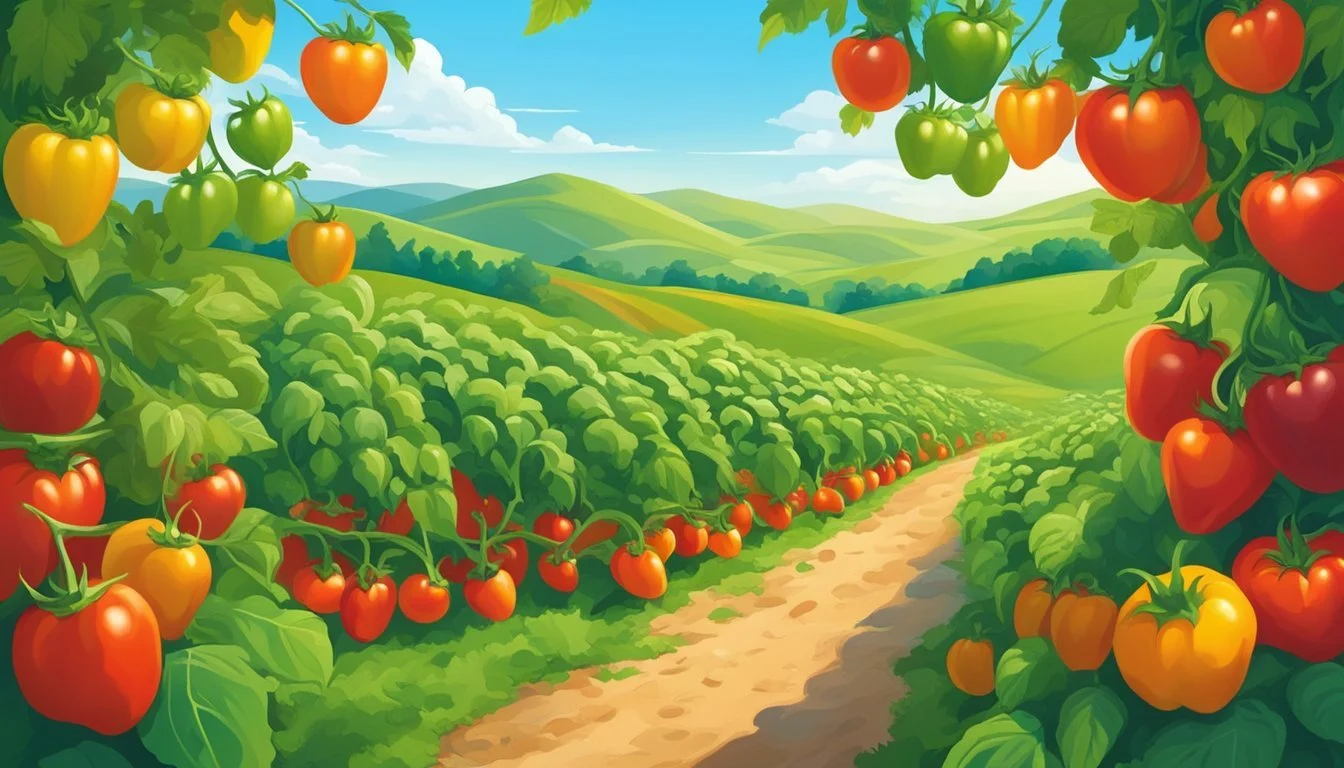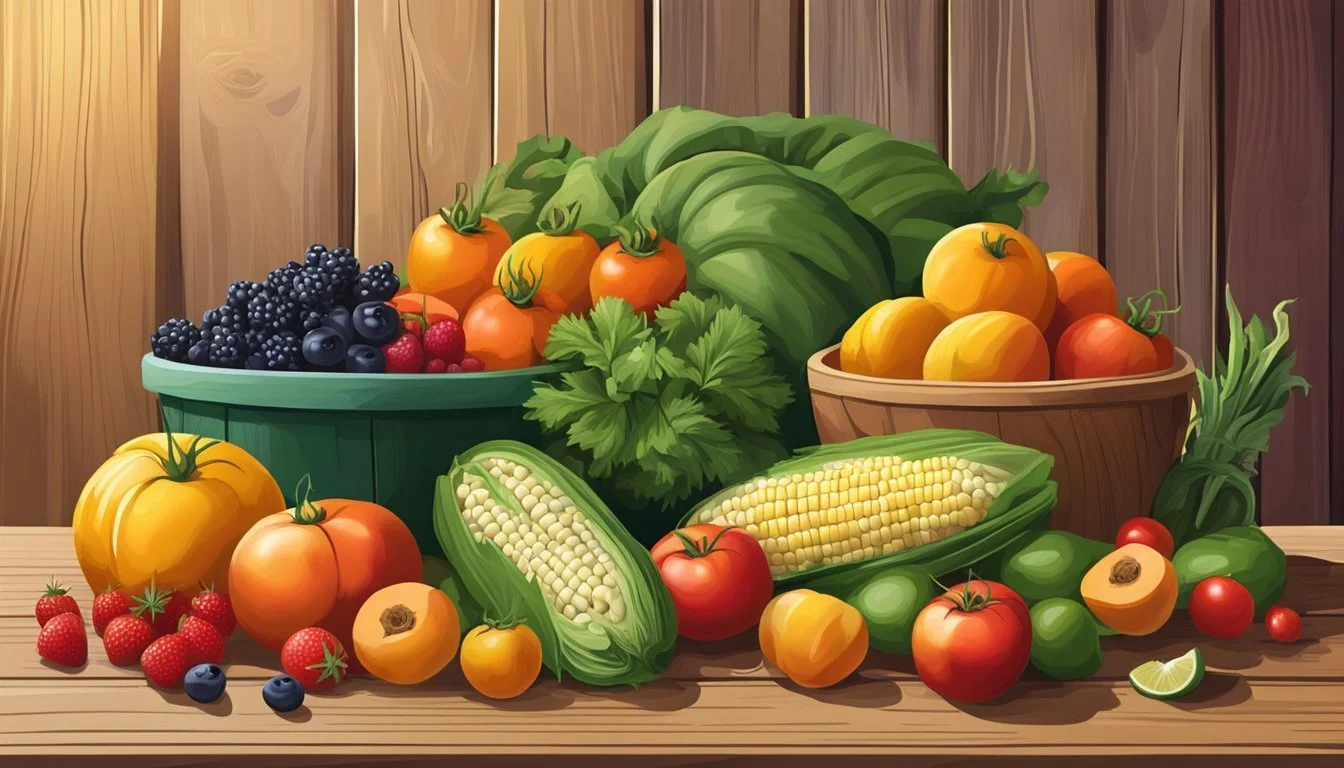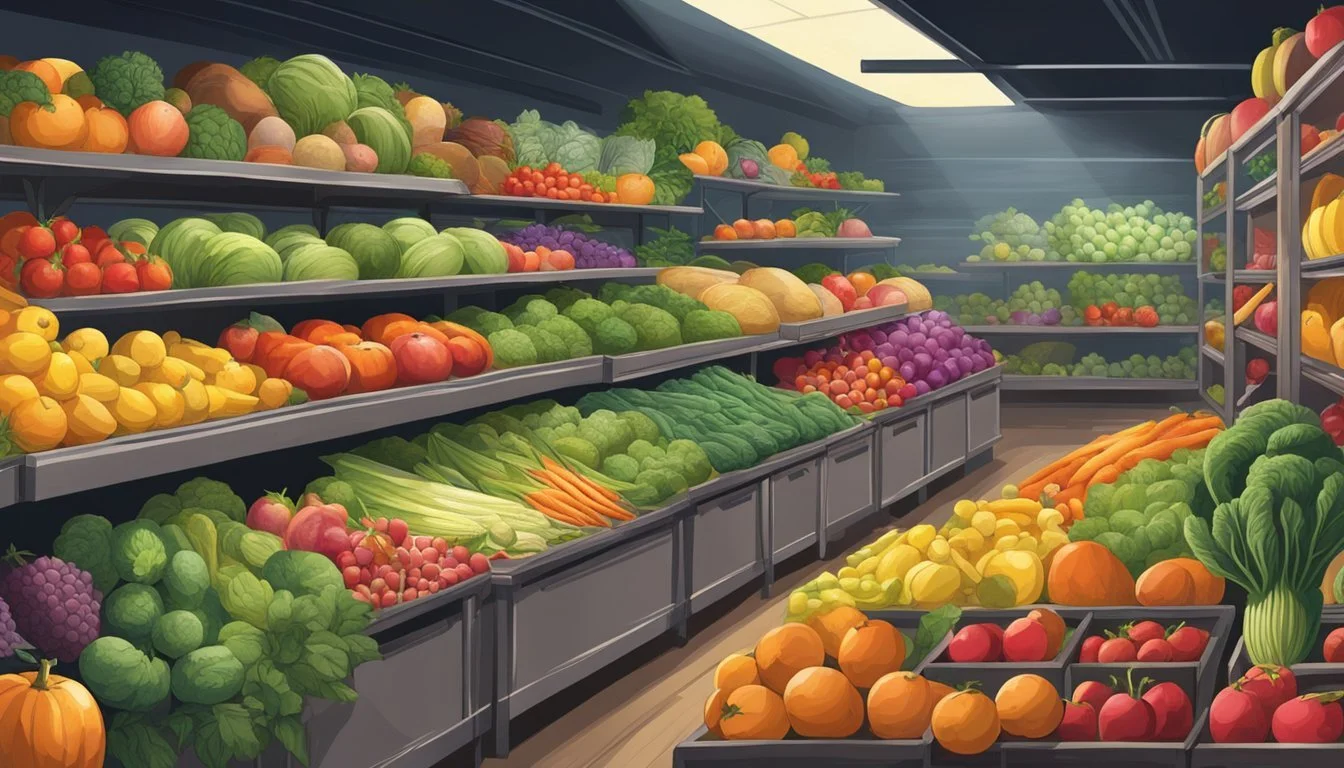Oregon Seasonal Fruit & Vegetables in July
Your Fresh Guide
This Article is Part of our Oregon Seasonal Fruit & Veg Calendar
July in Oregon is a showcase of the state's agricultural bounty, reflecting a climate that fosters a rich variety of fruits (What wine goes well with fruit?) and vegetables. During this time, the weather is typified by its warm days and cool nights, conditions that are ideal for developing the nuanced flavors and prime quality of produce. Farmers and gardeners across the region harvest a cornucopia of crops, benefiting from the state's fertile soils and sustainable farming practices.
The variety of produce available is extensive, as July marks the season where both fruit and vegetables reach their peak of ripeness. Consumers can expect to find an array of berries, including blueberries (how long do blueberries last?), blackberries (how long do blackberries last?), and the tail end of the strawberry season. Stone fruits like cherries (how long do cherries last?) and peaches also make a notable appearance in markets and orchards, their juicy ripeness a clear indicator of Oregon's conducive summer climate.
Vegetable gardens and fields offer their own summer treasures, with crops like broccoli (how long does broccoli last?), cauliflower, and carrots in full flourish. The state's approach to agriculture, often focusing on organic and locally sourced methods, ensures that these vegetables are not only fresh but also of high quality—aligning with a growing consumer demand for food transparency and sustainability. This month truly exemplifies the harmony between Oregon's climate and its agricultural output.
Seasonal Overview
July marks a period where the abundance and variety of produce in Oregon are at their peak. This month is pivotal for enjoying the freshest and most flavorful fruits and vegetables, as many are in the prime of their harvest season.
Understanding Seasonality
The concept of seasonality is central to Oregon's produce, as it dictates the availability and quality of fruits and vegetables throughout the year. In July, consumers can expect an assortment of produce that is not only at its peak flavor but also offers the highest nutritional value due to minimal transportation and storage time.
July's Prime Harvest
During July, Oregon's farms are bustling with the harvest of a multitude of fruits and vegetables. Here are some of the fresh picks available:
Fruits Vegetables Blackberries Broccoli Blueberries Brussels Sprouts Boysenberries Cabbage Raspberries (red) Carrots Cherries Cauliflower Apples Peaches Melons (including Cantaloupes (how long does cantaloupe last?))
Notable mention: Strawberries and rhubarb, while wrapping up their peak season, are still available and offer an exceptional taste during early July.
Oregon's Agricultural Climate
Oregon's moderate climate, characterized by warm, dry summers and cool, wet winters, is ideal for a diverse range of agricultural products. These conditions contribute significantly to the successful cultivation of the state's distinctive seasonal produce, which thrives during the summer months. The state's commitment to sustainable farming practices further ensures that the quality of July's harvest is exceptional and environmentally responsible.
Fruit Highlights
July in Oregon is a time of abundant fruit harvests, with a variety of berries and stone fruits reaching their peak ripeness.
Berries Galore
Strawberries: While their season starts in May, they continue to be a sweet treat through July.
Blackberries: This berry begins its season in July and is known for its plump, juicy quality.
Blueberries: The blueberry season is in full swing, offering plump, sweet berries ideal for pies and preserves.
Raspberries: These delicate fruits are available, adding their unique, tart flavor to the summer palette.
Stone Fruits in Peak
Cherries: Cherries have a short but sweet season with July being the last chance to enjoy this luscious fruit.
Apricots: They hit their stride in July, boasting a tender, velvety flesh that is perfect for fresh eating and jam-making.
Peaches and Nectarines: Both are juicy and at their flavor peak, with nectarines being the smoother-skinned variant.
Plums: A diverse group of plums becomes available, ranging from sweet to tart, perfect for snacking or culinary use.
Other Seasonal Fruits
Apples: Early varieties of apples start to come into season, hinting at the fall to come.
Melons: Various melons ripen under the warm sun, offering a refreshing respite from the summer heat.
Pears: While not yet at peak season, the earliest varieties of pears may start to appear by the end of July.
Vegetable Highlights
July in Oregon brings a rich bounty of vegetables to the table, from vibrant leafy greens to hearty root vegetables and the beginning of the season for various squash and corn varieties.
Leafy Greens and Cruciferous Vegetables
Oregon is verdant with leafy greens like lettuce and kale, which thrive in the cool summer climate. Broccoli and cabbage also reach their peak, providing crisp, fresh flavors perfect for salads and grilling.
Lettuce: Ideal for fresh salads, wraps
Kale: Nutrient-dense for smoothies, sautés
Broccoli: Great for steamed dishes, (What wine goes well with steamed dishes?) stir-frys
Cabbage: Versatile for slaws, fermented dishes like sauerkraut (how long does sauerkraut last?)
Root Vegetables and More
The soil yields a treasure of root vegetables, notably carrots and beets, known for their earthy sweetness, while radishes and turnips offer a peppery kick to dishes.
Carrots: Sweet, crunchy, suitable for roasts and purees
Beets: Deeply colored, ideal for roasts, salads
Radishes: Crisp, spicy, excellent in salads
Turnips: Tender when young, good for roasting or boiling
Squash and Corn Varieties
The fields come alive with the growth of summer squash and zucchini, alongside the first harvests of corn. These vegetables are summer staples, perfect for grilling or adding a touch of sweetness to any dish.
Zucchini: Mild, versatile for grilling, stuffing, and baking
Squash: Comes in many varieties, great for side dishes, casseroles
Corn: Sweet kernels, ideal for boiling, grilling, or salads
Herbs and Additional Produce
July in Oregon presents an abundance of fresh produce which includes not only fruits and vegetables but also a variety of herbs and edible flowers. The summer's warm weather encourages the growth of these diverse and aromatic additions that are perfect for enhancing the flavor and presentation of dishes.
Summer Herbs
In July, many household herbs thrive, and Oregon's gardens are rich with their scents and flavors. The following table lists herbs that are particularly robust during this month:
Herb Description Basil A staple in summer dishes, basil is perfect for pesto and pairs well with tomatoes. Mint Refreshing and cool, mint is ideal for drinks, desserts, and salads. Rosemary An aromatic herb that enlivens roasted meats (What wine goes well with roasted meats?) and vegetables. Thyme Versatile and subtle, it accompanies a variety of dishes, including those with chicken or fish. Sage Typically used in stuffings and meats, sage has a robust flavor.
These herbs not only contribute to the culinary landscape but also to the biodiversity within home gardens and local farms.
Edible Flowers
Aside from the herbs, July in Oregon sees the blossoming of edible flowers, offering a decorative and tasty flourish:
Borage: Star-shaped flowers that taste reminiscent of cucumber.
Calendula: Tangy and peppery, great for salads or as garnish.
Nasturtiums: With their vibrant hues, they provide a peppery punch similar to arugula.
One can find these edible flowers brightening up farmers' markets and garden beds, bringing both color and flavor to the summer palate. They are a visual delight and elevate the aesthetics of any dish.
Preparation and Consumption
In July, Oregon's bounty offers a range of fruits and vegetables that are perfect for various preparation and consumption methods. An understanding of how to prepare these seasonal offerings can enhance their natural flavors and nutritional benefits.
Fresh Consumption
Fresh consumption of produce ensures the highest level of nutrients and flavor. Here’s how one can enjoy Oregon's July harvest raw:
Berries (Blueberries, Blackberries, Raspberries): These are ideal for eating fresh out of hand. They can be rinsed and added to salads or yogurts for a burst of flavor.
Stone Fruits (Cherries, Apricots, Peaches): Stone fruits can be consumed directly after washing. They’re juicy and sweet, making them refreshing snacks or dessert options.
Leafy Greens (Lettuce, Spinach): Leafy greens are perfect for salads or sandwich toppings, offering crisp textures and fresh flavors.
Cooking Techniques
Cooking can transform the attributes of vegetables and fruits, often intensifying flavors or changing textures:
Grilling: Stone fruits like peaches develop a caramelized, rich flavor when grilled.
Steaming: Vegetables like broccoli retain their nutrients and are softened for easier consumption.
Baking: Berries and stone fruits can be baked into pies or crisps, concentrating their sugars and flavors.
Freezing: Berries freeze well for later use in smoothies or as toppings without significant loss of flavor.
Incorporating these fruits and vegetables into cooking provides variety and maximizes the enjoyment of Oregon’s seasonal produce.
Preservation and Storage
In July, Oregon's bountiful harvest provides an excellent opportunity for preserving the fresh flavors of seasonal crops. Preserving fruits and vegetables at their peak can ensure a supply of summer tastes even during colder months.
Canning and Preserving
The process of canning is particularly suitable for many of Oregon's July crops. Squash and cucumbers (how long do cucumbers last?) can be preserved as pickles, which provides a crisp, savory treat throughout the year. Fruits that are ripe in July, such as blackberries and Early Blueberries, can be made into jams and jellies.
Squash (including Zucchini):
Preparing: Wash and chop into consistent pieces.
Processing: Can as pickles or chutney.
Cucumbers:
Preparing: Wash and slice or keep whole.
Processing: Pickle with dill (how long does dill last?) and vinegar for classic dill pickles.
Freezing and Drying
Freezing is an easy and quick way to preserve the freshness of July crops. Vegetables like squash and cucumbers should be blanched before freezing to maintain texture and flavor. For fruits, one can create a single layer on a baking sheet to flash freeze, and then transfer to air-tight containers or freezer bags. Drying or dehydrating is another method, suitable for creating snacks like dried fruits or fruit leather. (how long does fruit leather last?)
Squash:
Preparing: Blanch slices or cubes, plunge into ice water, then drain.
Freezing: Lay out on a baking sheet, freeze, then pack into bags.
Cucumbers:
Preparing: Not typically recommended for freezing due to water content.
Drying: Thinly sliced cucumbers can be dried to create chips.
By following proper canning procedures and freezing techniques, one can enjoy the summer's harvest even during the off-season months.
Local Markets and Availability
July is a prime month in Oregon for finding a bounty of fresh, locally harvested produce, with summer squash among the popular items available at local markets. This period is characterized by an abundance of fresh fruits and vegetables that reflect the season's peak.
Farmers' Markets
Farmers' markets in Oregon are bustling in July, offering a venue for consumers to purchase direct from local producers. At these markets, one can expect to find summer squash, along with a variety of other seasonal produce like blueberries, broccoli, and blackberries. Specific items available may vary by location, but the focus is always on fresh and local, harvested at the height of ripeness.
Fruit & Vegetable Availability Summer Squash Available Blueberries Available Broccoli Available Blackberries Available
Community-Supported Agriculture (CSA)
Community-Supported Agriculture, or CSA, is an alternative, seasonal method for consumers to buy local, seasonal food directly from a farmer. In July, members receive shares of freshly picked produce, which often includes the season's best like crisp summer squash and juicy berries. CSAs support the local agricultural community and provide consumers with the freshest possible produce options.
Agricultural Practices in Oregon
In Oregon, the agricultural practices are fine-tuned to make the most of the growing season while maintaining the quality and sustainability of the state's diverse produce. Farmers across the state employ various techniques to ensure a thriving and environmentally-friendly food system.
Sustainable Farming
Farmers in Oregon often employ sustainable farming practices that support the long-term health of the soil and the surrounding ecosystems. They focus on strategies such as crop rotation, cover cropping, and minimal tillage which enhance soil fertility and reduce erosion. Such methods also contribute to better water retention and deter pests, reducing the need for synthetic fertilizers and pesticides. Many operations are incorporating integrated pest management (IPM) strategies as well, which use a combination of biological, cultural, physical, and chemical tools to manage pests in an economically and ecologically sound manner.
Organic Production
Oregon is a state well-known for its high-quality organic produce. Organic farmers adhere to strict guidelines to avoid the use of synthetic pesticides, herbicides, and fertilizers, instead relying on natural alternatives. They often employ:
Composting: to enrich the soil,
Biological pest control: utilizing beneficial insects or organisms to combat pests,
Conservation tillage: to preserve soil structure and biodiversity.
Furthermore, organic certification in Oregon requires rigorous adherence to national standards, ensuring that consumers receive genuinely organic products. This dedication to organic agriculture contributes to a sustainable and resilient food system within the state.








